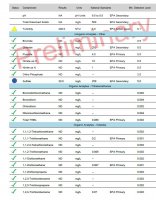Update: Called the lab. They where able to test for bacteria and the results where negative. I wont have any preliminary results on anything else until Monday the earliest. In the mean time I'm continuing my research and came across something scary which might also explain why my chlorine injection AND CARBON FILTER is located at the end of the cycle and not as the first step: I'm quoting a section from this page:https://www.nj.gov/dep/rpp/rms/agreedown/radwater.pdf. It basically says that CARBON IS NOT TO BE USED UNTIL THE WATER IS FREE OF RADON OTHERWISE THE CARBON CAN BECOME A RADIOACTIVE SOURCE
"If you are currently using an activated carbon system to treat your well water, and your gross alpha results indicate that treatment is 4 The DEP recommends the following actions for homeowners who test and are concerned about radioactivity in their drinking water: If testing shows that gross alpha activity is greater than 15 picocuries per liter, water treatment is recommended. If gross alpha activity is greater than 5 but less than 15 picocuries per liter, testing for Radium 226 and Radium 228 is advised. If the combined radium levels are above 5 picocuries per liter, water treatment is recommended. Alternatively, a homeowner may evaluate the additional cost of radium testing and determine whether it is better simply to proceed to water treatment. If gross alpha activity is less than 5 picocuries per liter, no further action is required. necessary, then the treatment system for gross alpha should be placed before the carbon filter. This is to prevent possible accumulation of radioactivity on the carbon bed. For further information on all such units, contact your local health officer to determine which type is best for your home and water quality situation before installing a radioactivity removal system. (Ask if a local health department permit is required.) If you install a water treatment system, conduct another gross alpha test after the installation to verify that the system is working effectively to reduce radioactivity to an acceptable level."
Same papers also reads the following!
"How Can I Reduce Radioactivity? You can reduce radioactivity in your drinking water by selecting one of the following options: Hook up to a municipal water system if this option is available. Install a water softener or ion exchange water treatment system (known as a point-of-entry system). For the average home, this is usually the most feasible and cost effective method of reducing radioactivity in drinking......"
I wasn't aware that ion exchange eliminates radon and _I will look into the chemistry involved going forward_. Im simply posting this now for the benefit of the users in this forum.
"If you are currently using an activated carbon system to treat your well water, and your gross alpha results indicate that treatment is 4 The DEP recommends the following actions for homeowners who test and are concerned about radioactivity in their drinking water: If testing shows that gross alpha activity is greater than 15 picocuries per liter, water treatment is recommended. If gross alpha activity is greater than 5 but less than 15 picocuries per liter, testing for Radium 226 and Radium 228 is advised. If the combined radium levels are above 5 picocuries per liter, water treatment is recommended. Alternatively, a homeowner may evaluate the additional cost of radium testing and determine whether it is better simply to proceed to water treatment. If gross alpha activity is less than 5 picocuries per liter, no further action is required. necessary, then the treatment system for gross alpha should be placed before the carbon filter. This is to prevent possible accumulation of radioactivity on the carbon bed. For further information on all such units, contact your local health officer to determine which type is best for your home and water quality situation before installing a radioactivity removal system. (Ask if a local health department permit is required.) If you install a water treatment system, conduct another gross alpha test after the installation to verify that the system is working effectively to reduce radioactivity to an acceptable level."
Same papers also reads the following!
"How Can I Reduce Radioactivity? You can reduce radioactivity in your drinking water by selecting one of the following options: Hook up to a municipal water system if this option is available. Install a water softener or ion exchange water treatment system (known as a point-of-entry system). For the average home, this is usually the most feasible and cost effective method of reducing radioactivity in drinking......"
I wasn't aware that ion exchange eliminates radon and _I will look into the chemistry involved going forward_. Im simply posting this now for the benefit of the users in this forum.

